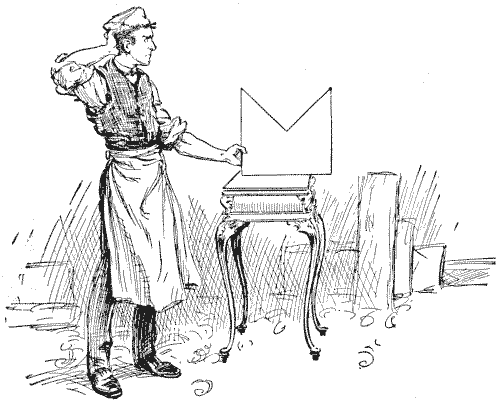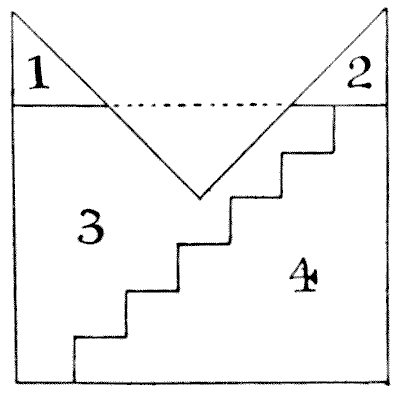
The figure that is perplexing the carpenter in the illustration represents a mitre. It will be seen that its proportions are those of a square with one quarter removed. The puzzle is to cut it into five pieces that will fit together and form a perfect square. I show an attempt, published in America, to perform the feat in four pieces, based on what is known as the "step principle," but it is a fallacy.

We are told first to cut oft the pieces $1$ and $2$ and pack them into the triangular space marked off by the dotted line, and so form a rectangle.
So far, so good. Now, we are directed to apply the old step principle, as shown, and, by moving down the piece $4$ one step, form the required square. But, unfortunately, it does not produce a square: only an oblong. Call the three long sides of the mitre $84$ in. each. Then, before cutting the steps, our rectangle in three pieces will be $84\times63.$ The steps must be $10\frac 12$ in. in height and $12$ in. in breadth. Therefore, by moving down a step we reduce by $12$ in. the side $84$ in. and increase by $10\frac 12$ in. the side $63$ in. Hence our final rectangle must be $72$ in. $\times 73\frac 12$ in., which certainly is not a square! The fact is, the step principle can only be applied to rectangles with sides of particular relative lengths. For example, if the shorter side, in this case, were $61 \frac57$ (instead of $63$), then the step method would apply. For the steps would then be $10\frac 27$ in. in height and $12$ in. in breadth. Note that $61 \frac 57 \times 84=72^2.$
At present, no solution has been found in four pieces, and I do not believe one possible.
Solutions: 1
This eBook is for the use of anyone anywhere in the United States and most other parts of the world at no cost and with almost no restrictions whatsoever. You may copy it, give it away or re-use it under the terms of the Project Gutenberg License included with this edition or online at http://www.gutenberg.org. If you are not located in the United States, you'll have to check the laws of the country where you are located before using this ebook.